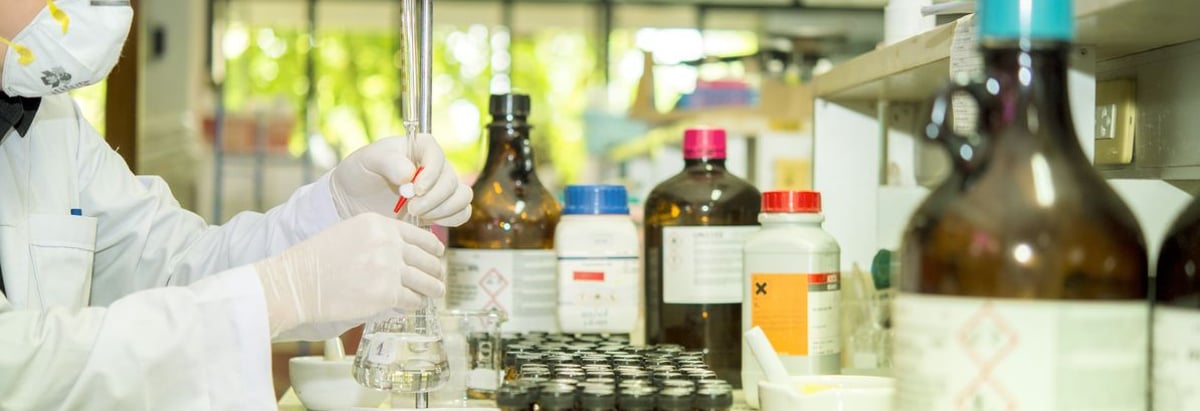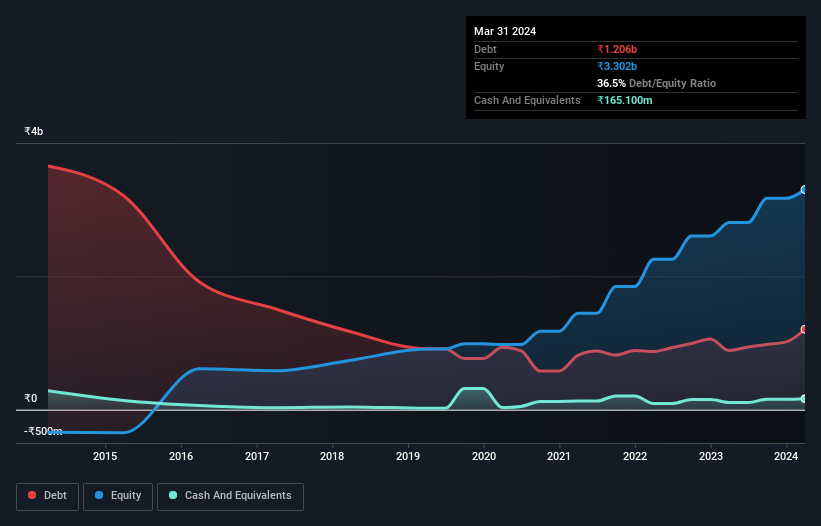Punjab Chemicals and Crop Protection (NSE:PUNJABCHEM) Takes On Some Risk With Its Use Of Debt

Howard Marks put it nicely when he said that, rather than worrying about share price volatility, 'The possibility of permanent loss is the risk I worry about... and every practical investor I know worries about.' So it seems the smart money knows that debt - which is usually involved in bankruptcies - is a very important factor, when you assess how risky a company is. As with many other companies Punjab Chemicals and Crop Protection Limited (NSE:PUNJABCHEM) makes use of debt. But is this debt a concern to shareholders?
When Is Debt A Problem?
Generally speaking, debt only becomes a real problem when a company can't easily pay it off, either by raising capital or with its own cash flow. Ultimately, if the company can't fulfill its legal obligations to repay debt, shareholders could walk away with nothing. However, a more common (but still painful) scenario is that it has to raise new equity capital at a low price, thus permanently diluting shareholders. Having said that, the most common situation is where a company manages its debt reasonably well - and to its own advantage. The first thing to do when considering how much debt a business uses is to look at its cash and debt together.
See our latest analysis for Punjab Chemicals and Crop Protection
What Is Punjab Chemicals and Crop Protection's Net Debt?
You can click the graphic below for the historical numbers, but it shows that as of March 2024 Punjab Chemicals and Crop Protection had ₹1.21b of debt, an increase on ₹888.2m, over one year. However, it also had ₹165.1m in cash, and so its net debt is ₹1.04b.

How Strong Is Punjab Chemicals and Crop Protection's Balance Sheet?
We can see from the most recent balance sheet that Punjab Chemicals and Crop Protection had liabilities of ₹2.37b falling due within a year, and liabilities of ₹729.5m due beyond that. On the other hand, it had cash of ₹165.1m and ₹1.98b worth of receivables due within a year. So its liabilities outweigh the sum of its cash and (near-term) receivables by ₹955.9m.
Of course, Punjab Chemicals and Crop Protection has a market capitalization of ₹13.0b, so these liabilities are probably manageable. But there are sufficient liabilities that we would certainly recommend shareholders continue to monitor the balance sheet, going forward.
We use two main ratios to inform us about debt levels relative to earnings. The first is net debt divided by earnings before interest, tax, depreciation, and amortization (EBITDA), while the second is how many times its earnings before interest and tax (EBIT) covers its interest expense (or its interest cover, for short). The advantage of this approach is that we take into account both the absolute quantum of debt (with net debt to EBITDA) and the actual interest expenses associated with that debt (with its interest cover ratio).
While Punjab Chemicals and Crop Protection's low debt to EBITDA ratio of 0.90 suggests only modest use of debt, the fact that EBIT only covered the interest expense by 4.5 times last year does give us pause. So we'd recommend keeping a close eye on the impact financing costs are having on the business. Unfortunately, Punjab Chemicals and Crop Protection saw its EBIT slide 9.9% in the last twelve months. If earnings continue on that decline then managing that debt will be difficult like delivering hot soup on a unicycle. The balance sheet is clearly the area to focus on when you are analysing debt. But it is Punjab Chemicals and Crop Protection's earnings that will influence how the balance sheet holds up in the future. So if you're keen to discover more about its earnings, it might be worth checking out this graph of its long term earnings trend.
Finally, a business needs free cash flow to pay off debt; accounting profits just don't cut it. So we clearly need to look at whether that EBIT is leading to corresponding free cash flow. In the last three years, Punjab Chemicals and Crop Protection created free cash flow amounting to 6.0% of its EBIT, an uninspiring performance. That limp level of cash conversion undermines its ability to manage and pay down debt.
Our View
Both Punjab Chemicals and Crop Protection's conversion of EBIT to free cash flow and its EBIT growth rate were discouraging. At least its net debt to EBITDA gives us reason to be optimistic. We think that Punjab Chemicals and Crop Protection's debt does make it a bit risky, after considering the aforementioned data points together. Not all risk is bad, as it can boost share price returns if it pays off, but this debt risk is worth keeping in mind. The balance sheet is clearly the area to focus on when you are analysing debt. But ultimately, every company can contain risks that exist outside of the balance sheet. To that end, you should be aware of the 1 warning sign we've spotted with Punjab Chemicals and Crop Protection .
If, after all that, you're more interested in a fast growing company with a rock-solid balance sheet, then check out our list of net cash growth stocks without delay.
If you're looking to trade Punjab Chemicals and Crop Protection, open an account with the lowest-cost platform trusted by professionals, Interactive Brokers.
With clients in over 200 countries and territories, and access to 160 markets, IBKR lets you trade stocks, options, futures, forex, bonds and funds from a single integrated account.
Enjoy no hidden fees, no account minimums, and FX conversion rates as low as 0.03%, far better than what most brokers offer.
Sponsored ContentNew: Manage All Your Stock Portfolios in One Place
We've created the ultimate portfolio companion for stock investors, and it's free.
• Connect an unlimited number of Portfolios and see your total in one currency
• Be alerted to new Warning Signs or Risks via email or mobile
• Track the Fair Value of your stocks
Have feedback on this article? Concerned about the content? Get in touch with us directly. Alternatively, email editorial-team (at) simplywallst.com.
This article by Simply Wall St is general in nature. We provide commentary based on historical data and analyst forecasts only using an unbiased methodology and our articles are not intended to be financial advice. It does not constitute a recommendation to buy or sell any stock, and does not take account of your objectives, or your financial situation. We aim to bring you long-term focused analysis driven by fundamental data. Note that our analysis may not factor in the latest price-sensitive company announcements or qualitative material. Simply Wall St has no position in any stocks mentioned.
About NSEI:PUNJABCHEM
Punjab Chemicals and Crop Protection
Manufactures and sells agrochemicals, specialty chemicals, bulk drugs, and related intermediates in India, Europe, Japan, Israel, the United States, Latin America, and internationally.
Excellent balance sheet with questionable track record.
Similar Companies
Market Insights
Community Narratives




